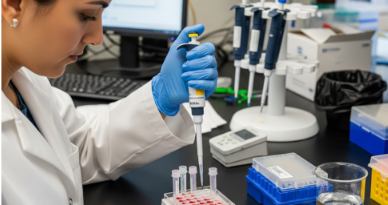How Secondary Antibodies Enhance Sensitivity in Protein Detection Assays?

Proteins are large, complex molecules made up of smaller units of amino acids. They are the building blocks of life and are present in every cell and tissue in the body. They maintain structure, enable chemical reactions, defend against disease, transmit signals, and support movements.
The sequence of amino acids determines the protein’s shape and function. Proteins can be structural, functional, or regulatory, depending on their role in the body. However, over time, proteins lose their structure and misfold. This can be due to age, stress, environmental factors, etc. As a result, they can’t perform their normal functions in the body, leading to various diseases.
At times, scientists rely on protein detection, where they detect and quantify proteins in complex samples using various assay techniques. This helps understand cellular processes, diagnose diseases, and develop new therapies.
Scientists need highly sensitive tools that help them detect and quantify even the lowest concentration of proteins in a sample. Here is where secondary antibodies for protein detection come into play.
What are Secondary Antibodies?
Antibodies are proteins that are designed to identify and bind to specific antigens. There are two types of antibodies: Primary and secondary antibodies.
Primary antibodies specifically identify and bind to the target protein of interest. They are known for high specificity. On the other hand, secondary antibodies bind to primary antibodies rather than directly to the target protein. They are usually conjugated with a reporter molecule, such as an enzyme or a fluorescent dye. These receptors help in signal detection.
Secondary antibodies can amplify the signal generated during an assay. So, they are ideal for detecting low-abundance proteins in a sample.
How Secondary Antibodies Work and Enhance Sensitivity?
Secondary antibodies identify and bind to the Fc region of primary antibodies. As a result, it increases the number of detected tags per target protein. This “signal amplification” boosts the overall sensitivity of the assay and makes it easier to detect low-concentration proteins that may be missed by primary antibodies.
Secondary antibodies are known for:
- High sensitivity
- Versatility
- Better signal-to-noise ratio
- Providing flexibility in the detection method
What are the Applications of Secondary Antibodies in Protein Detection Assays?
Secondary antibodies are widely used in various protein detection assays, including:
Western Blotting
Western blotting is used to detect specific proteins in a sample. First, proteins are separated based on size and transferred to a membrane. Then, a primary antibody binds to the target protein. Next, a secondary antibody binds to the primary antibody.
This secondary antibody carries an enzyme that produces a visible signal, like a color or light. The signal is stronger because one primary antibody can bind to many secondary antibodies. This makes it easier to detect proteins, even in very low amounts.
Enzyme-Linked Immunosorbent Assay (ELISA)
ELISA is a method used to measure the amount of protein in a sample. The process starts with a primary antibody capturing the target protein. Then, a secondary antibody with an enzyme attaches to the primary antibody. The enzyme reacts with a chemical to produce a color change or light. The intensity of the color or light shows how much protein is present. This makes ELISA very precise and sensitive.
Immunofluorescence
Last but not least, secondary antibodies are used in immunofluorescence. In this technique, fluorescent dyes are used to see proteins inside cells or tissues under a microscope. The primary antibody binds to the protein. Then, a fluorescent secondary antibody binds to the primary antibody. This increases the brightness of the signal. It helps scientists see proteins that are in very small amounts or in specific parts of the cell.
The Bottom Line
Secondary antibodies can make the signal stronger, allow detection of low-abundance proteins, and help locate proteins in cells and tissues. So, they are used in many techniques to detect proteins more clearly.
However, using high-quality antibodies for your experiment is recommended. Otherwise, you may have to compromise on your results.


